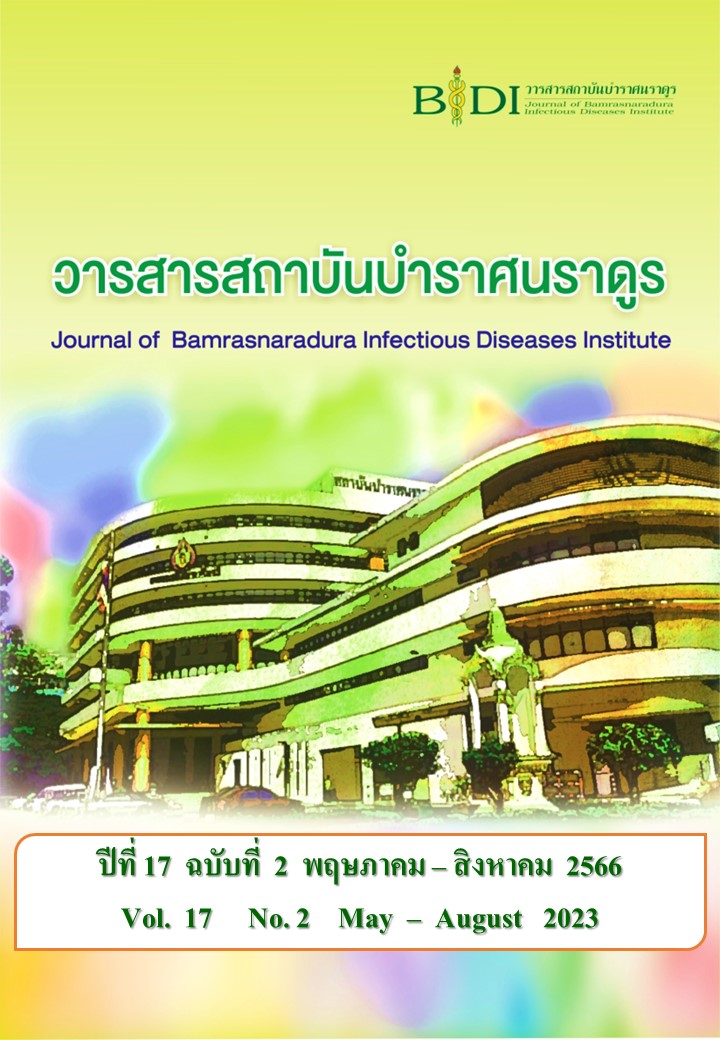ปัจจัยที่มีความสัมพันธ์ต่อพฤติกรรมการป้องกันโรคไวรัสโคโรนาสายพันธุ์ใหม่ 2019 ในประชาชน เขตเทศบาลนครพระนครศรีอยุธยา จังหวัดพระนครศรีอยุธยา
Main Article Content
บทคัดย่อ
การวิจัยเชิงพรรณนาแบบภาคตัดขวางนี้มีวัตถุประสงค์เพื่อศึกษาระดับความรู้ ทัศนคติ และพฤติกรรมการป้องกันโรคไวรัสโคโรนาสายพันธุ์ใหม่ 2019 (โควิด 19) และเพื่อศึกษาปัจจัยที่มีความสัมพันธ์ต่อพฤติกรรมการป้องกันโรคโควิด 19 ในประชาชน เขตเทศบาลนครพระนครศรีอยุธยา จังหวัดพระนครศรีอยุธยา จำนวน 180 คน เก็บรวบรวมข้อมูลโดยใช้แบบสอบถาม ระหว่างเดือนมีนาคม-พฤษภาคม 2564 แบบสอบถามมีค่า IOC เท่ากับ 0.70 – 0.92 ค่าความเชื่อมั่น KR-20 เท่ากับ 0.84 และค่าความเชื่อมั่นสัมประสิทธิ์อัลฟาของครอนบาค เท่ากับ 0.81 วิเคราะห์ข้อมูลโดยใช้สถิติเชิงพรรณนา สถิติ Chi-Square และสถิติ Pearson product moment correlation
ผลการศึกษาพบว่า กลุ่มตัวอย่างมีความรู้เกี่ยวกับโรคโควิด 19 อยู่ในระดับปานกลาง มีระดับทัศนคติและระดับพฤติกรรมเกี่ยวกับการป้องกันโรคโควิด 19 อยู่ในระดับสูง ส่วนปัจจัยที่มีความสัมพันธ์ต่อพฤติกรรมการป้องกันโรคโควิด 19 คือ ระดับความรู้ มีความสัมพันธ์ทางบวก อย่างมีนัยสำคัญทางสถิติที่ระดับ < 0.001 (r=0.340) และปัจจัยส่วนบุคคล ได้แก่ ระดับการศึกษา รายได้ การไปสถานที่เสี่ยงโดยการไปงานบุญ และการสัมผัสกับบุคคลที่มาจากพื้นที่เสี่ยง มีความสัมพันธ์กับพฤติกรรมการป้องกันโรคโควิด 19 อย่างมีนัยสำคัญทางสถิติที่ระดับ 0.05
ผลการศึกษาครั้งนี้ชี้ให้เห็นว่า ความรู้ส่งผลเชิงบวกต่อพฤติกรรมการป้องกันโรคโควิด 19 ดังนั้น การส่งเสริมให้ประชาชนมีความรอบรู้ด้านสุขภาพจะทำให้ประชาชนที่ได้รับข้อมูลข่าวสารจากหลากหลายช่องทาง สามารถวิเคราะห์ข้อมูลต่างๆ โดยเฉพาะข้อมูลความรู้เกี่ยวกับเชื้อไวรัส การติดเชื้อ รวมถึงการแพร่กระจายของโรค และสามารถตัดสินใจด้านสุขภาพได้อย่างถูกต้อง ซึ่งส่งผลถึงการปฏิบัติตนที่ถูกต้องเหมาะสมได้ด้วยตนเอง เพื่อลดการแพร่ระบาดของโรคโควิด 19 ต่อไป
Article Details
เอกสารอ้างอิง
Hu B, Guo H, Zhou P, Shi Z. Characteristics of SARS-CoV-2 and COVID-19. Nat Rev Microbiol 2020 Oct 6; 19: 141-154. doi: 10.1038/s41579-020-00459-7.
World Health Organization. Coronavirus disease (COVID-19) pandemic: number at a glance [internet]. 2021 [cited 2021 Jun 23]. Available from: https://www.who.int/emergencies/diseases/novel-coronavirus-2019
Racha P, Kongros J, Sodchien T. The development of nursing service system for chronic non – communicable diseases (NCDs) patients in the COVID-19 outbreak situation. Region 4-5 Medical Journal 2020; 7(9): 40-55. (in Thai)
The Center for the Administration of the Situation due to the Outbreak of the Communicable Disease Coronavirus (COVID-19) Thailand. The situation of COVID-19 in Thailand during April 1, 2021 – June 23, 2021 [internet]. 2021 [cited 2021 Jun 23]. Available from: https://www.moicovid.com/22/06/2021/uncategorized/3883/ (in Thai)
Central for Disease Control and Prevention United States of America. COVID-19 vaccines work [internet]. 2021 [cited 2021 Jun 23]. Available from: https://www.cdc.gov/coronavirus/2019-ncov/vaccines/effectiveness/work.html
Nawsuwan K, Singweratham N, Thepaksorn P. Compositions and indicators for successful implementation of novel coronavirus (COVID-19) in the community of village health volunteers (VHVs) in Thailand. The Southern College Network Journal of Nursing and Public Health 2020; 12(3): 195-212. (in Thai)
The Center for the Administration of the Situation due to the Outbreak of the Communicable Disease Coronavirus (COVID-19) Phranakhon Si Ayutthaya Province Thailand. The situation of COVID-19 on June 23, 2021 [internet]. 2021 [cited 2021 Jun 23]. Available from: https://covid.ayutthaya.go.th/frontpage (in Thai)
Green LW, Kreuter MW. Health promotion planning and education and ecological approach. 3rd ed. California: Mayfield Publishing Company; 1999.
Jirawatkul A. Statistics for health science research. Bangkok: Wittayaphat; 2010.
Glomjai T, Kaewjiboon J, Chachvarat T. Knowledge and behavior of people regarding self-care prevention from novel coronavirus 2019 (COVID-19). Journal of Nursing, Public Health, and Education 2020; 21(2): 29-39. (in Thai)
Bloom BS. Handbook on formative and summative evaluation of student learning. New York: McGraw–Hill; 1971.
Best JW. Research in education. 3rd ed. New Jersey: Prentice Hall; 1977.
Morasakul B, Punthasee P. Knowledge and prevention behaviors regarding COVID-19 among the first-year nursing students of Saint Theresa International College and Saint Louis College. Regional Health Promotion Center 9 Journal 2021; 15(37): 179-95. (in Thai)
Khumsaen, N. Knowledge, attitudes, and preventive behaviors of COVID-19 among people living in amphoe U-thong, Suphanburi province. Journal of Prachomklao College of Nursing, Phetchaburi Province 2021; 4(1): 33-48. (in Thai)
Reuben RC, Danladi MMA, Saleh DA, Ejembi PE. Knowledge, attitudes and practices towards COVID-19: an epidemiological survey in north-central Nigeria. J Community Health 2020 Jul 7; 46(3): 457-70. doi: 10.1007/s10900-020-00881-1. PMID: 32638198.
Al ahdab S. A cross-sectional survey of knowledge, attitude and practice (KAP) towards COVID-19 pandemic among the Syrian residents. BMC Public Health 2021 Feb 5; 21: 296. doi: 10.1186/s12889-021-10353-3. PMID: 33546652.
Mohamed AAO, Elhassan EAM, Mohamed AO, Mohammed AA, edris HA, Mahgoop MA, et al. Knowledge, attitude and practice of the Sudanese people towards COVID-19: an online survey. BMC Public Health 2021 Feb 3; 21: 274. doi: 10.1186/s12889-021-10319-5. PMID: 33535995.
Hussain I, Majeed A, Imran I, Ullah M, Hashmi FK, Saeed H, et al. Knowledge, attitude, and practices toward COVID-19 in primary healthcare providers: a cross-sectional study from three tertiary care hospitals of Peshawar, Pakistan. J Community Health 2020 Jul 6; 46(3): 441-9. doi: 10.1007/s10900-020-00879-9. PMID: 32632645.


